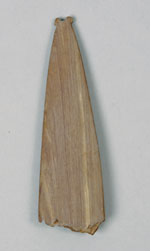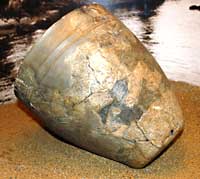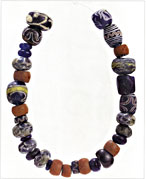Prehistoric Vilhelmina
By prehistoric times, we usually mean the Stone Age, the Bronze Age and the Iron Age. Together, these periods span over more than 10 000 years - from 10 000 B.C to about 1050 A.D. Below is a sample of what has been uncovered in Vilhelmina from this era.
The Vilhelmina area has been populated ever since the regression of the inland ice. Actually, Vilhelmina is the municipiality with the most archeological remains in Västerbotten (over 2000 registered items). The oldest find in these parts of the land is a 10 000 year old cooking pit by Lake Vojmsjön.
The Stone Age
During the Stone Age, about 5000 years ago, it was common to excavate the floors of the hut you were living in. Food and rubbish was thrown just outside the hut which in time formed large banks of waste, shards of stone and broken tools. The bone material found in these banks show that people mainly ate moose and beaver, but also black grouse and bear.

Knife from Gråtanån
© Västerbottens museum
Tools like whetstones and different types of arrow and spear heads have been found in these areas. The tools are usually made from local rock like slate, quartz and quartzite. The single most common find are scrapers in different shapes and sizes, used to prepare animal hides.
The Bronze and Iron Age
There are many ceramic finds from the Bronze and Iron Age containing asbestos. Ceramic shard analysis' suggest that people (luckily) didn't cook in these pots but used them for making bronze objects and smithing iron.

The Kultsjö pot. © Västerbottens museum
In the 1940's, one of the most beautiful asbestos pots in Sweden was found by the beach of lake Kultsjön in Vilhelmina. From the Iron Age there are also many finds of beautiful iron arrow heads, knives and axes - but also of pearl necklaces and buckles. One famous find is from Lake Maksjön where a large amount of glass beads, three bronze buckles and some iron knives were discovered. The many valuable objects suggest that this could have been a grave from around A.D. 700 or 800.

The Maksjö necklace
© Västerbottens museum
There are many ancient Sami remains in the Swedish mountains. Amongst other things there is something referred to as Stalotomtningar, considered to be remains of seasonal camps or huts that were used hunting wild reindeer. They are considered to date back to A.D. 700 - 1400. The name Stalo comes from the Sami word for a dangerous being or giant, stállo. Nowadays not many people believe that giants have resided in these ancient remains.
Sites worth visiting:
- Gråtanån and Dalasjö: Hut remains and hunting pits from the Stone Age.
- Remdalen: Stalotomtningar
- Prehistorical periods

- Stone Age 10 000 - 1800 B.C.
- Bronze Age 1800 - 500 B.C.
- Iron Age 500 B.C - 1050 A.D.